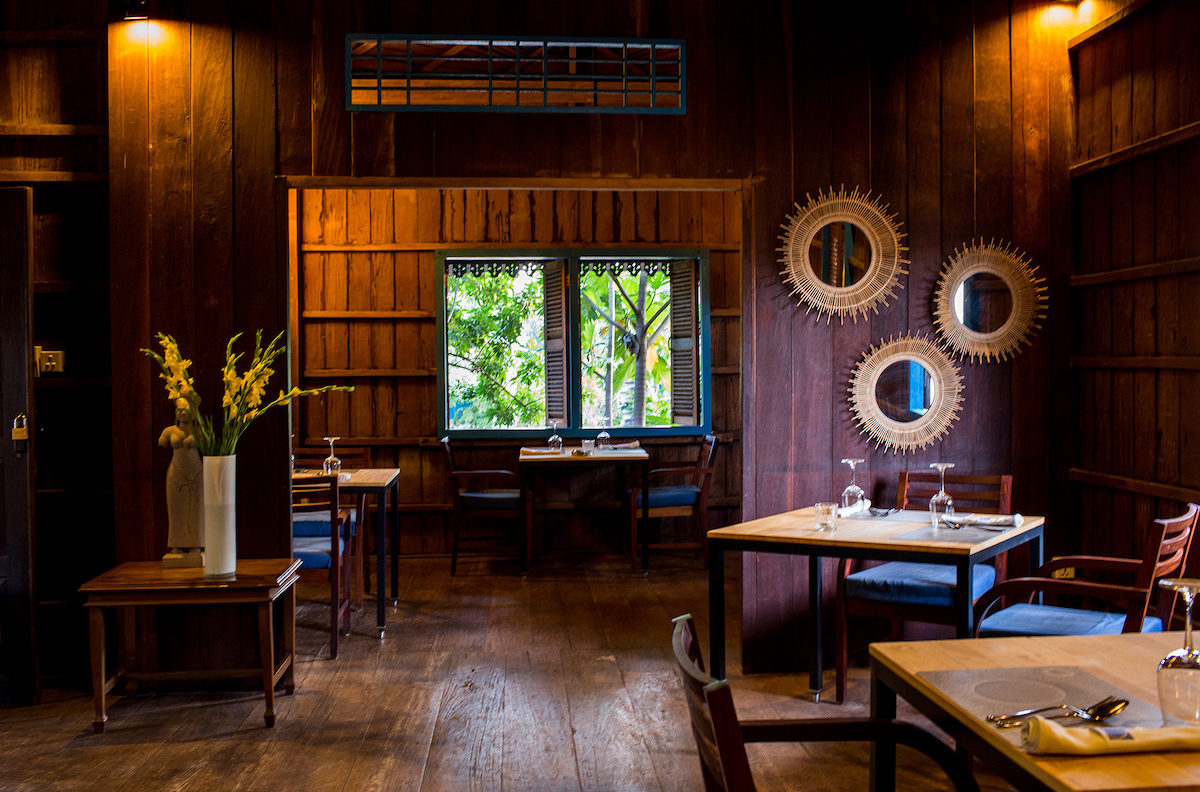There are certain places—show-stopping hotels, award-winning restaurants, local dive bars, or incomparable vintage shops—that are worth planning your whole trip around. Cuisine Wat Damnak in Siem Reap, Cambodia, is one of those places.
In Siem Reap, the constant hustle and bustle of the developing rivertown begins to fade as you leave the city center and make your way across the Siem Reap River, off the main road, and down a dusty residential street. Blaring car horns and the cacophony of motorcycles and tuk-tuks are soon replaced by quiet conversations and the soothing chorus of crickets and cicadas in the dark. There, behind a wall of lush tropical trees, inside a country-style wooden house, is where you’ll find Cuisine Wat Damnak.
For three hours a night, five days a week, the owners, Chef Joannès Rivière and his wife Carole Salmon, open their home to hungry travelers. The first floor includes garden seating as well as a modern air-conditioned dining room decorated with local artwork while the fan-cooled second floor retains the house’s rustic charm with exposed wood panels on the walls and floors, a thatched roof, and open windows exposing diners to the balmy air. When dinner is served, beautifully plated dishes arrive showcasing traditional Cambodian flavors reimagined using French cooking techniques to create a farm-to-table degustation experience that combines the best of Old World and new.
The restaurant’s two tasting menus change about every two weeks to reflect the seasons and terroir of the region. While most produce in the city’s fine kitchens is imported, Cuisine Wat Damnak’s ingredients are sourced almost entirely on-site, from nearby farms, or foraged from around Siem Reap Province, including fresh fish and other seafood from the Mekong and Tonle Sap. On any given morning, Rivière, who is fluent in Khmer, can be seen strolling through the Old Market for his next culinary inspiration. For him, the most important part of Cambodian cuisine is the ingredients.
Born and raised by a family of farmers and chefs near Roanne, a small French town in Loire, Rivière arrived in Cambodia as a volunteer cooking teacher at the revered Sala Baï Hotel School. It was in this foreign place, thousands of miles away from France, that he fell in love with his wife and a country. After his time as executive chef at the grand Hôtel de la Paix (now Park Hyatt Siem Reap), he and Carole opened their restaurant in 2011 to showcase his nearly ten years of research and recipes acquired from Cambodian grandmothers and pre-war cookbooks, some of which are slowly being forgotten.
“Cambodian food has changed my cooking style in many ways,” Rivière said. “The idea of mixing meat and fish, the idea of over or under cooking something on purpose, or even the idea of doing an entire meal without dairy, has changed my way of running a kitchen.”
Whether it’s your first time or you’re a frequent visitor, there’s always something new for your taste buds to discover at Cuisine Wat Damnak.
Why it’s worth the trip:
Sure, it’s the only restaurant in Cambodia to be included among the prestigious “Asia’s 50 Best Restaurants,” but the real prize is being able to taste indigenous ingredients and flavors you likely won’t experience the same way anywhere else, such as Mekong langoustine bathed in rice wine and kampot pepper, considered the best in the world, or Tonle Sap croaker fish swimming in a spicy curry of wild sour leaves, green jackfruit, and winged beans. Fermented fish pastes, such as prahok or mam, are also among the country’s staples you will find creatively used on the menu in addition to edible flowers and rice paddy herbs, and the chef’s latest choice of seasonal fruits, like mangosteen or jackfruit, served with kaffir lime chili salt.
You’ll like it here if…
You’re a traveling locavore on a budget that’s craving a village vibe and a taste of the local culture and cuisine.
Price breakdown:
Choose between the five-course meal for $29 or six-course meal for $34. Drinks, such as tamarind-infused cocktails, are extra. Like almost all restaurants in Cambodia, Cuisine Wat Damnak accepts Mastercard and Visa as well as U.S. dollars and the Khmer riel.
The crowd:
Due to the price point, you’ll find both locals and travelers in attendance, ranging from backpackers to the five-star hotel crowd.
What to bring:
Be sure to download PassApp Cambodia—a local ride-sharing app—before you head out. It’ll come in handy when hailing a taxi or tuk-tuk late at night.
Pro tip:
Plan ahead. The best time to travel to Siem Reap is during the dry season from November to March. The restaurant is closed on Sundays and Mondays and reservations are recommended. Let Chef Rivière and his team know of any dietary restrictions you may have. They’ll be more than happy to accommodate.
While you’re in the area…
The ancient temples of Angkor should be first on everyone’s list. After an early morning admiring Angkor Wat, Ta Prohm, and the stone faces at Bayon, take a stroll through Kandal Village. The up-and-coming neighborhood is known for its collection of hip cafes and colorful boutiques. If you’d rather rest your feet, enjoy a refreshing afternoon ale at Siem Reap Brewpub—the Saison Ale is Chef Rivière’s favorite there. En route to dinner, stop by One Eleven Gallery for a collection of contemporary art from local and international artists. After dinner, head to Miss Wong, a chic speakeasy near Pub Street, for live music and their signature Indochine Martini.






